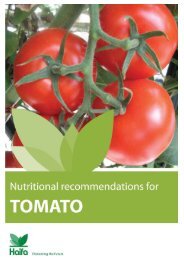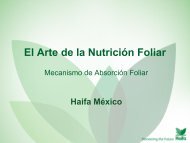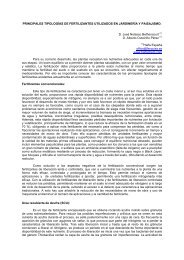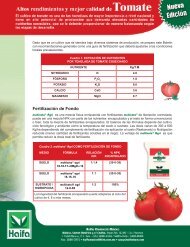Crop Guide: Nutritional recommendations for Cucumber - Haifa-Group
Crop Guide: Nutritional recommendations for Cucumber - Haifa-Group
Crop Guide: Nutritional recommendations for Cucumber - Haifa-Group
You also want an ePaper? Increase the reach of your titles
YUMPU automatically turns print PDFs into web optimized ePapers that Google loves.
4.2 Generic fertilizers <strong>recommendations</strong><br />
Table 4.2: A general fool-proof recommendation <strong>for</strong> N-P-K fertilization regime and timing<br />
allocation be<strong>for</strong>e and during the growth season, based on soil tests.<br />
Fertilizer timing<br />
Nitrogen<br />
kg/ha<br />
Soil phosphorus level<br />
(kg/ha P2O5)<br />
Very<br />
Low Med High<br />
high<br />
48<br />
Soil potassium level<br />
(kg/ha K2O)<br />
Low Med High Very<br />
high<br />
Total recommended 120-140 170 120 60 30 230 170 120 60<br />
Pre-plant: broadcast<br />
& incorporate<br />
60 120 60 0 0 170 120 60 0<br />
Band-place* 30 60 60 60 30 60 60 60 60<br />
Side-dress when vines<br />
begin to run, or<br />
fertigate<br />
*15 cm to side of seed row and 10 cm deep<br />
4.2.1 General fertilizing principles <strong>for</strong> cucumbers<br />
Pre-plant treatments<br />
30 0 0 0 0 0 0 0 0<br />
Amending soil pH<br />
<strong>Cucumber</strong>s prefer light textured soils that are well drained, high in organic matter and have a pH of<br />
6 - 6.8. Adapted to a wide-range of soils, but will produce early in sandy soils. <strong>Cucumber</strong>s are fairly<br />
tolerant to acid soils (down to pH 5.5).<br />
Greenhouse cucumbers generally grow quite well in a wide range of soil pH (5.5-7.5), but a pH of<br />
6.0-6.5 <strong>for</strong> mineral soils and a pH of 5.0-5.5 <strong>for</strong> organic soils are generally accepted as optimum.<br />
When the pH is too low, add ground calcitic limestone, or an equal amount of dolomitic limestone<br />
when the magnesium level in the soil is low, to raise it to a desirable level. Use the rates given in<br />
Table 4.3 as a guide; the actual lime requirement is best assessed by an appropriate laboratory test.<br />
Table 4.3: Lime requirements <strong>for</strong> correcting soil pH to 6.5<br />
Soil pH<br />
Sandy Loam Loam, silty loam<br />
Lime mass (t/ha)<br />
Clay loam, organic<br />
6.0 3.0 4.5 6.0<br />
5.5 6.0 9.0 12.0<br />
5.0 9.0 12.0 18.0<br />
4.5 12.0 15.0 24.0<br />
4.0 15.0 18.0 30.0<br />
Note: The rates of lime suggested are <strong>for</strong> the top 15 cm of soil. If acidity has to be corrected to a greater soil<br />
depth, increase the rates accordingly.<br />
Usually the pH in most greenhouse mineral soils is above the optimum pH range (6.0-6.5). A simple,<br />
though temporary, solution to a high pH problem is to add peat, without neutralizing its acidity<br />
with limestone. Peat also helps to maintain a good soil structure, but it must be added yearly to<br />
make up <strong>for</strong> loss through decomposition.












